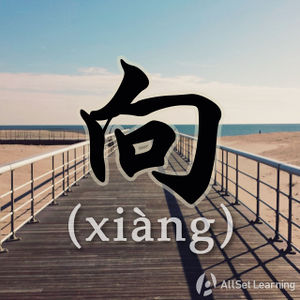Difference between revisions of "Expressing "towards" with "xiang""
| Line 21: | Line 21: | ||
*<em>向</em> 左 转 。<span class="pinyin"><em>Xiàng</em> zuǒ zhuǎn.</span><span class="trans">Turn to the left.</span> | *<em>向</em> 左 转 。<span class="pinyin"><em>Xiàng</em> zuǒ zhuǎn.</span><span class="trans">Turn to the left.</span> | ||
*老师 正 <em>向</em> 我们 走 来 。<span class="pinyin">Lǎoshī zhèng <em>xiàng</em> wǒmen zǒu lái.</span><span class="trans">The teacher is currently walking towards us.</span> | *老师 正 <em>向</em> 我们 走 来 。<span class="pinyin">Lǎoshī zhèng <em>xiàng</em> wǒmen zǒu lái.</span><span class="trans">The teacher is currently walking towards us.</span> | ||
| − | *火车 已经 开 了 ,她 还 在 <em>向</em> 我 招手 。<span class="pinyin">Huǒchē yǐjīng kāi le, tā hái zài <em>xiàng</em> wǒ zhāoshǒu.</span><span class="trans">The train already | + | *火车 已经 开 了 ,她 还 在 <em>向</em> 我 招手 。<span class="pinyin">Huǒchē yǐjīng kāi le, tā hái zài <em>xiàng</em> wǒ zhāoshǒu.</span><span class="trans">The train already departed. She kept waving at me.</span> |
*你 必须 <em>向</em> 他 道歉 !<span class="pinyin">Nǐ bìxū <em>xiàng</em> tā dàoqiàn!</span><span class="trans">You must apologize to him!</span> | *你 必须 <em>向</em> 他 道歉 !<span class="pinyin">Nǐ bìxū <em>xiàng</em> tā dàoqiàn!</span><span class="trans">You must apologize to him!</span> | ||
*这 件 事 你 应该 <em>向</em> 老板 汇报 一下 。<span class="pinyin">Zhè jiàn shì nǐ yīnggāi <em>xiàng</em> lǎobǎn huìbào yīxià.</span><span class="trans">You should report this matter to the boss!</span> | *这 件 事 你 应该 <em>向</em> 老板 汇报 一下 。<span class="pinyin">Zhè jiàn shì nǐ yīnggāi <em>xiàng</em> lǎobǎn huìbào yīxià.</span><span class="trans">You should report this matter to the boss!</span> | ||
Revision as of 14:46, 27 November 2018
-
Level
-
Similar to
-
Used for
-
Keywords
向 (xiàng) is a preposition that means "towards" and is used often with certain verbs. These usages need to be learned together with 向.
Contents
Used as "towards"
Structure
When used as a preposition, 向 indicates an action that is performed towards a reference point but doesn't have any actual motion towards that point.
向 + Direction / Person + Verb
Examples
- 向 东 走 。Walk to the east.
- 向 前 看 。Look forward.
- 向 左 转 。Turn to the left.
- 老师 正 向 我们 走 来 。The teacher is currently walking towards us.
- 火车 已经 开 了 ,她 还 在 向 我 招手 。The train already departed. She kept waving at me.
- 你 必须 向 他 道歉 !You must apologize to him!
- 这 件 事 你 应该 向 老板 汇报 一下 。You should report this matter to the boss!
Used as "from"
Whereas in English we would say "learn from someone," in Chinese this would be expressed as "learn toward someone," as in the following example (and famous propaganda slogan):
- 向 雷锋 同志 学习 !Learn from Comrade Lei Feng!
More examples:
- 我 不 喜欢 向 朋友 借钱 。I don't like to borrow money from my friends.
- 你 会 向 陌生人 求助 吗 ?Would you ask strangers for help?
- 我们 都 没 经验 ,是 来 向 你 请教 的 。None of us have experience. We're here to ask you for advice.



